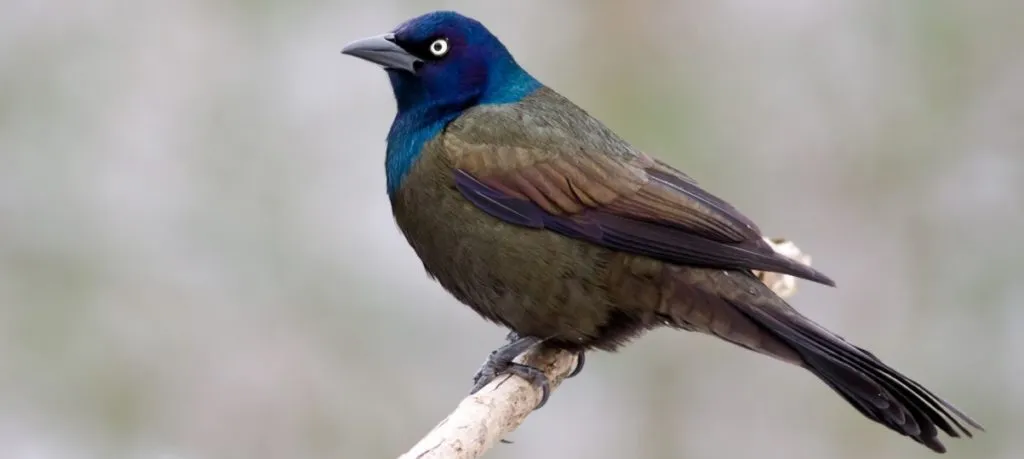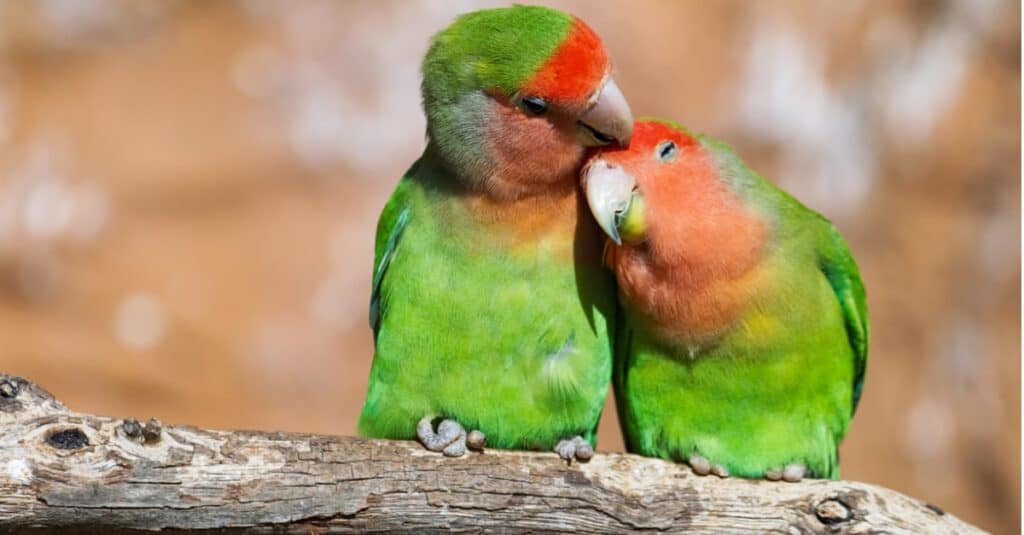Exploring the wondrous world of avian species, one can’t help but admire the fusion of colors uniquely exhibited by certain bird species—black and bluebirds. The combination is visually stunning and offers intriguing insights into the diverse, fascinating world of ornithology.
Welcome to “Black and Blue Birds A Comprehensive Guide to Identification and Facts,” where we dive deep into understanding these fascinating creatures. This guide will familiarize you with various types of these birds, their identifying features, fascinating facts, and unique traits. By delving into this comprehensive overview, bird enthusiasts, ornithologists, and researchers alike will broaden their knowledge about these enigmatic winged species, strengthening their grasp on their distinctive habits, nesting patterns, and geographic preferences.
So fasten your metaphorical seatbelts because we are about to embark on a fascinating journey around the world of black and blue birds.
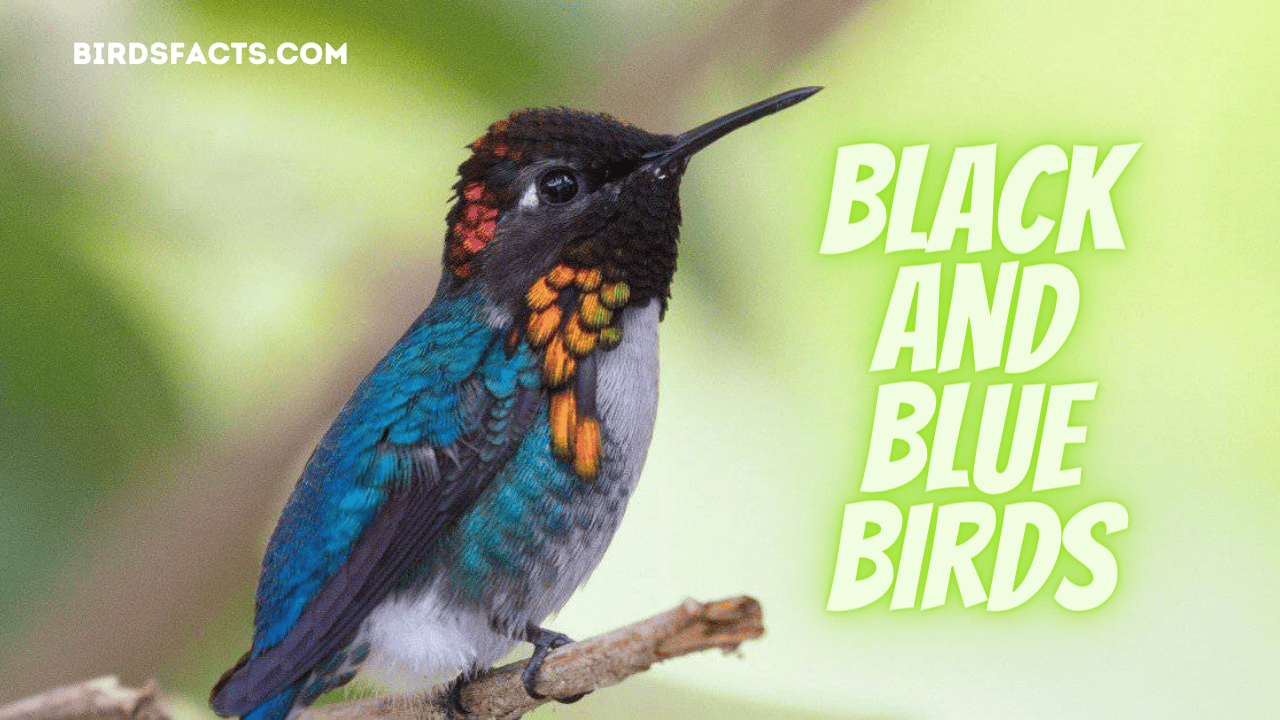
Black and Blue Birds
Black and Blue Birds
- Eurasian Magpie
- Black-Throated Blue Warbler
- Blue Grosbeak
- Blue Bunting
- Tree Swallow
- Shining Honeycreeper
- Bee Hummingbird
- Cerulean Warbler
- Common Grackle
- Purple Martin
- Indigo Bunting
- Steller’s Jay
- Black-billed Magpie
- Brown-Headed Cowbird
Eurasian Magpie
The Eurasian Magpie, scientifically known as Pica pica, is a fascinating bird found in various parts of Europe, Asia, and North Africa. One of the most distinctive features of the Eurasian Magpie is its striking black-and-white plumage, which contrasts beautifully against its bright blue-green wings. With a wingspan of up to 60 centimeters, these birds are excellent fliers and can cover great distances during their migration journeys. The Eurasian Magpie has a varied diet, consisting of insects, small mammals, fruits, and even the eggs and chicks of other birds.
Their sharp beaks are perfectly adapted for feasting on various prey. Regarding nesting, Eurasian Magpies prefer to build their nests in the upper branches of trees, where they are safe from predators. The incubation period for their eggs is around 21 days, and the chicks leave the nest after about a month.
As they grow, the vibrant colors of the Eurasian magpies become more pronounced, with their black feathers turning a glossy blue-black and their white feathers becoming brilliant white. These birds are known for their intelligence and mischievous behavior, often stealing shiny objects to add to their nests. Unfortunately, the biggest threat to the Eurasian Magpie is habitat loss due to deforestation and urban development.
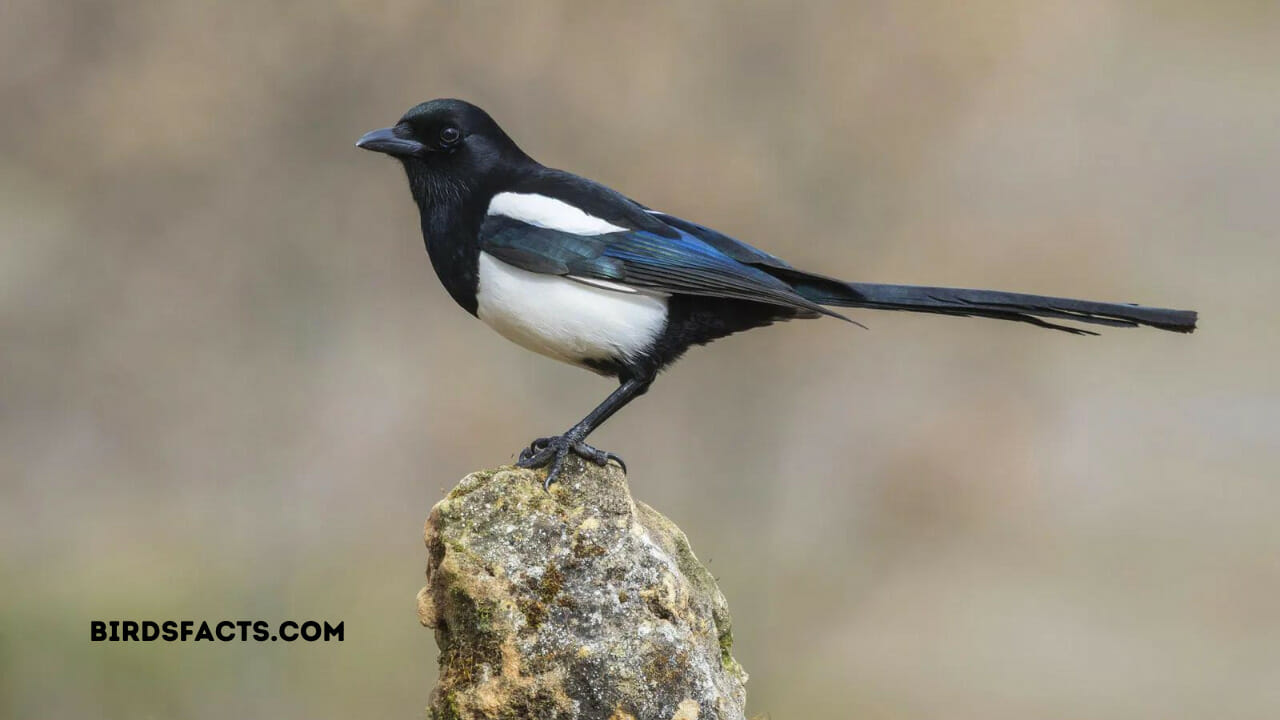
black bird with shiny blue head
However, despite this, the species is still widespread, and its estimated population is around tens of millions. The Eurasian Magpie plays an important role in its ecosystem, as it helps to control pest populations by preying on insects and small mammals. The Eurasian Magpie is truly a remarkable bird with its striking appearance, intelligent behavior, and diverse diet.
| Feature | Description |
|---|---|
| Common Name | Eurasian Magpie |
| Scientific Name | Pica pica |
| Distribution | Europe, Asia, and North Africa |
| Plumage | Striking black-and-white plumage with bright blue-green wings |
| Wingspan | Up to 60 centimeters |
| Diet | Insects, small mammals, fruits, eggs, and chicks of other birds |
| Nesting | Upper branches of trees |
| Incubation Period | Approximately 21 days |
| Fledging Period | Around a month |
| Color Changes | Black feathers turn glossy blue-black, white feathers become brilliant white |
| Behavior | Intelligent and mischievous, known for stealing shiny objects for nests |
| Threats | Habitat loss due to deforestation and urban development |
| Population | Estimated around tens of millions |
| Ecological Role | Helps control pest populations by preying on insects and small mammals |
Black-Throated Blue Warbler
The Black-Throated Blue Warbler, scientifically known as Setophaga caerulescens, is a small and colorful bird in the eastern regions of the United States and Canada. This warbler is known for its distinctive black throat and blue plumage, making it easily recognizable in the field.
With a wingspan of approximately 7 to 8 inches and a weight of around 0.3 to 0.4 ounces, the Black-Throated Blue Warbler is a lightweight bird that spends most of its time foraging for insects and spiders in the understory of deciduous forests. Its diet mainly consists of caterpillars, beetles, and other arthropods, providing the necessary energy for migration and breeding activities.
During the breeding season, the Black-Throated Blue Warbler constructs its nests in the low branches of trees or shrubs, typically located in dense vegetation. The incubation lasts about 11 to 12 days, with the male and female taking turns sitting on the eggs. Once the eggs hatch, the newborn chicks rely on their parents for food and protection until they are ready to fledge.
The biggest threat to the Black-Throated Blue Warbler population is habitat loss due to deforestation. As the forests are cleared for urban development or agriculture, the suitable nesting and foraging habitats for these birds are destroyed, leading to population declines. Currently, the estimated population size of the Black-Throated Blue Warbler is around 20 million individuals. Despite this relatively large number, the conservation status of this species is of concern, and efforts are being made to protect its habitat and ensure its survival.

blackbird blue head
Overall, the Black-Throated Blue Warbler is a fascinating bird with its striking coloration, distinctive features, and unique song. Its presence in the eastern woodlands brings joy to birdwatchers and nature enthusiasts and reminds them of the importance of preserving our natural habitats.
| Feature | Description |
|---|---|
| Common Name | Black-Throated Blue Warbler |
| Scientific Name | Setophaga caerulescens |
| Distribution | Eastern regions of the United States and Canada |
| Plumage | Distinctive black throat and blue plumage |
| Wingspan | Approximately 7 to 8 inches |
| Weight | Around 0.3 to 0.4 ounces |
| Foraging Habits | Spends most of its time foraging for insects and spiders in the understory of deciduous forests |
| Diet | Mainly consists of caterpillars, beetles, and other arthropods |
| Nesting | Nests constructed in low branches of trees or shrubs, typically in dense vegetation |
| Incubation Period | About 11 to 12 days |
| Parental Care | Both male and female take turns sitting on the eggs and caring for the chicks |
| Threats | Habitat loss due to deforestation for urban development and agriculture |
| Population | Estimated around 20 million individuals |
| Conservation Status | Of concern; efforts being made to protect its habitat and ensure its survival |
| Unique Characteristics | Striking coloration, distinctive features, and unique song |
Blue Grosbeak
The Blue Grosbeak, scientifically known as Passerina caerulea, is a beautiful bird in various locations across North and Central America. Its most distinctive feature is its vibrant blue feathers, which make it a striking sight in its habitat. The Blue Grosbeak has a wingspan of around 9-10 inches and weighs approximately 1 ounce. It has an estimated population size of around 1.2 million individuals. However, one of the biggest threats to the Blue Grosbeak is the loss of its natural habitat due to deforestation and urbanization.
The Blue Grosbeak primarily preys on insects, spiders, and seeds. It is a ground forager and uses its strong beak to crack open its prey. A fun fact about the Blue Grosbeak is that it undergoes a molting process during its second year of life, which changes its coloration. As a juvenile, the Blue Grosbeak has a brownish color, but it develops its distinctive blue plumage as it matures.
Regarding its habitat, the Blue Grosbeak prefers open grasslands, brushy areas, and forest edges. It builds its nests in shrubs or small trees, typically a few feet above the ground. The incubation period for the Blue Grosbeak is around 11-12 days, and the young birds fledge after about 10-12 days.
Common predators of the Blue Grosbeak include snakes, raccoons, and birds of prey.
The Blue Grosbeak belongs to the cardinal family and is one of the 46 species within the genus Passerina. It can be found in various United States, Mexico, and Central America regions. During the breeding season, the Blue Grosbeak migrates to its breeding grounds in the southern United States and Mexico. It is known for its melodious song and displays its vocal behavior during courtship and territorial defense.

black bird dark blue head
The conservation status of the Blue Grosbeak is currently listed as “Least Concern” by the IUCN. However, the loss and fragmentation of its habitat pose a significant threat to its population. Efforts are being made to protect and restore its natural habitat to ensure the survival of this stunning bird.
| Feature | Description |
|---|---|
| Scientific Name | Passerina caerulea |
| Location | North and Central America |
| Distinctive Feature | Vibrant blue feathers |
| Wingspan | Around 9-10 inches |
| Weight | Approximately 1 ounce |
| Estimated Population | Around 1.2 million |
| Major Threat | Loss of natural habitat due to deforestation and urbanization |
| Primary Prey | Insects, spiders, and seeds |
| Foraging Technique | Ground foraging; uses its beak to crack open its prey |
| Molting Process | Undergoes molting during its second year of life which changes its coloration |
| Habitat Preference | Open grasslands, brushy areas, and forest edges |
| Nesting Habit | Builds nests in shrubs or small trees, typically a few feet above the ground |
| Incubation Period | Around 11-12 days |
| Fledging Period | Young birds fledge after about 10-12 days |
| Common Predators | Snakes, raccoons, and birds of prey |
| Family and Genus | Cardinal family, Genus Passerina |
| Regions Found | Various regions in United States, Mexico, and Central America |
| Breeding Habit | Migrates to breeding grounds in the southern United States and Mexico during breeding season |
| Vocal Behavior | Known for its melodious song, often used during courtship and territorial defense |
| Conservation Status | Listed as “Least Concern” by IUCN. However, habitat loss and fragmentation pose a major threat |
Blue Bunting
The Blue Bunting, scientifically known as Passerina cyanea, is a small bird with vibrant blue plumage. This species is primarily found in North America, specifically in the southwestern and northern Mexico parts of the United States. Blue Buntings are insectivorous and primarily prey on insects and seeds. They have a distinct feature of bright blue feathers, which make them easily recognizable in their habitat.
The wingspan of a Blue Bunting is approximately 9 inches, and they have a short incubation period of about 11 to 13 days. These birds prefer semi-open habitats like shrubby areas, woodlands, and riparian zones. Predators of the Blue Bunting include snakes, birds of prey, and mammals. In terms of diet, these buntings consume various insects, seeds, fruits, and nectar.
Blue Buntings belong to the family Cardinalidae, and there this bird has six recognized subspecies estimated population size for this species is currently unknown, which makes it difficult to assess its conservation status. However, habitat loss and fragmentation are considered the biggest threats to the Blue Bunting population.
Blue Buntings typically molt between their first and second year, and during this process, their feathers change from brown to the characteristic bright blue color. These birds weigh around 10 grams and have a length of about 5 inches. In terms of lifestyle, Blue Buntings are primarily solitary birds, although they may form small flocks during migration. Their favorite food includes grasshoppers, caterpillars, and seeds.
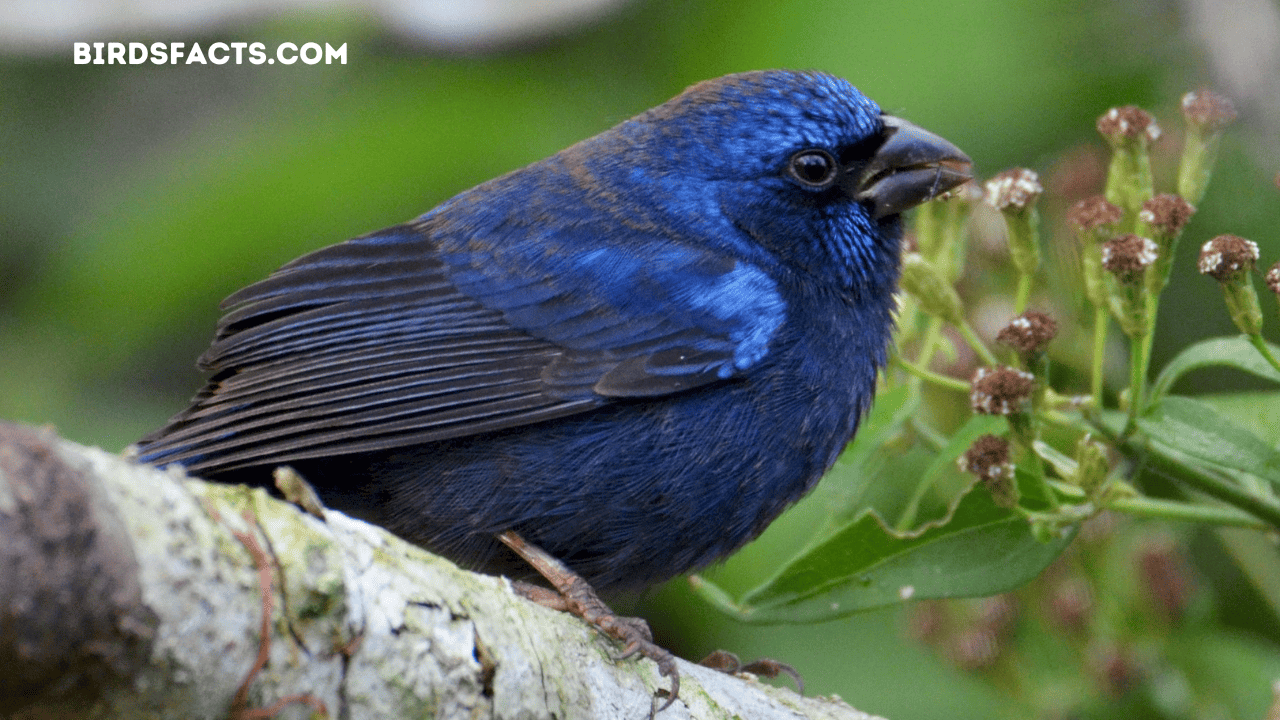
black bird dark blue head
The field identification of the Blue Bunting includes the bright blue coloration of the male and the more subtly colored female. The Blue Bunting has a conservation status of Least Concern, meaning it is not currently considered at significant risk of extinction. The Blue Bunting is a visually stunning bird with fascinating habits and characteristics.
| Information Category | Details |
|---|---|
| Scientific Name | Passerina cyanea |
| Common Name | Blue Bunting |
| Physical Characteristics | Small bird with vibrant blue plumage. Wingspan is approximately 9 inches. Weighs around 10 grams and has a length of about 5 inches. Feathers change from brown to bright blue color between the first and second year. |
| Habitat | Primarily found in North America, specifically in the southwestern parts of the United States and northern Mexico. Prefers semi-open habitats like shrubby areas, woodlands, and riparian zones. |
| Diet | Insectivorous. Mainly preys on insects and seeds, but also consumes various fruits and nectar. Favorite food includes grasshoppers, caterpillars, and seeds. |
| Lifestyle | Primarily solitary birds, although they may form small flocks during migration. |
| Reproduction | Short incubation period of about 11 to 13 days. |
| Predators | Snakes, birds of prey, and mammals. |
| Conservation Status | Least Concern. Habitat loss and fragmentation are the biggest threats. Exact population size is currently unknown. |
| Family and Subspecies | Belongs to the family Cardinalidae. This bird has six recognized subspecies. |
| Notable Features | Bright blue feathers make them easily recognizable in their habitat. Field identification includes the bright blue coloration of the male and the more subtly colored female. |
Tree Swallow
The Tree Swallow, known as Tachycineta bicolor, is a small bird species in North and Central America. It is known for its distinctive features, including its iridescent blue-green feathers and white underparts. With a wingspan of around 11 inches, the Tree Swallow weighs approximately 20 grams and is 5 to 6 inches long. It inhabits various open habitats, such as forests, marshes, and fields.
The Tree Swallow mainly feeds on a diet of insects, particularly those in the air. This bird species is a cavity nester, often choosing tree hollows or nest boxes for breeding and raising their young. The incubation lasts about 14 to 15 days, with chicks fledging after 18 to 24 days. Despite its small size, the Tree Swallow is known for its agility and swift flying abilities.
Its favorite food is believed to be flying insects, which it catches on the wing. Regarding its field identification, the Tree Swallow can be easily recognized by its vibrant blue upperparts and white underparts. The Tree Swallow species are further classified into four subspecies, each with distinct traits and distribution range. The population size of Tree Swallows is estimated to range from 20 million to 100 million individuals.
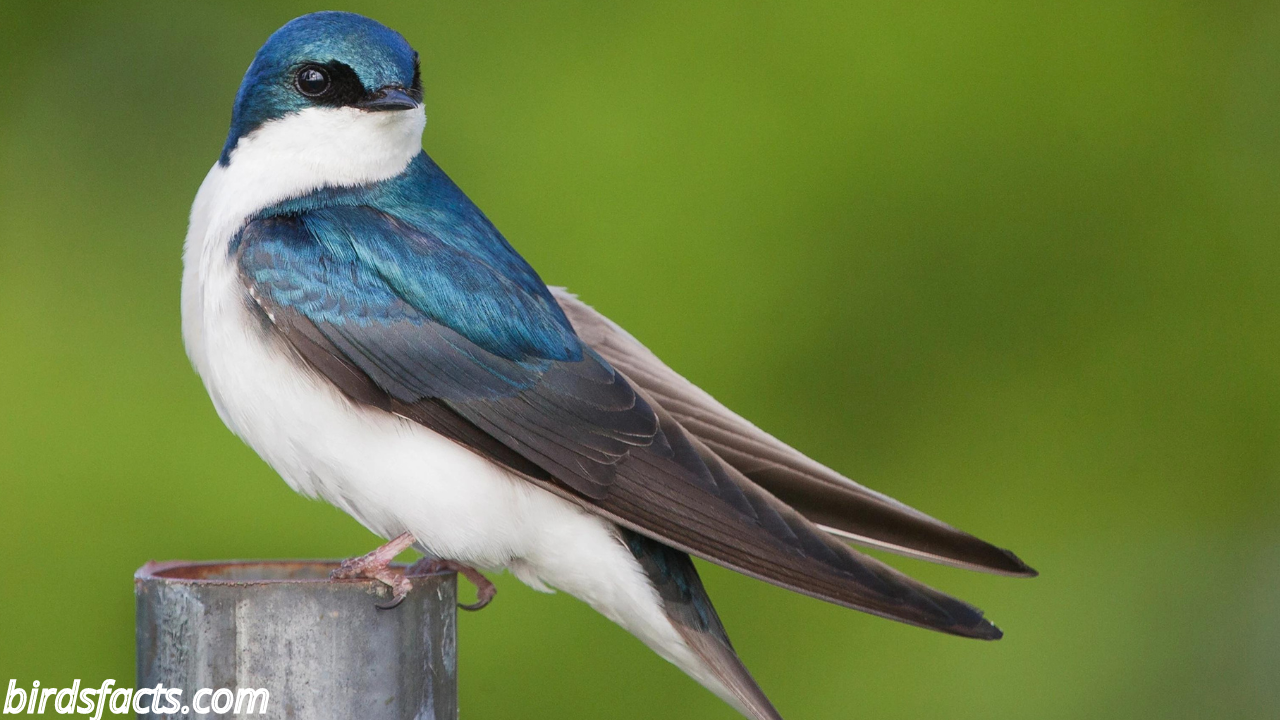
black bird with blue
However, their biggest threat is the loss of suitable nesting sites due to habitat destruction and competition with other bird species. Despite these challenges, the Tree Swallow is considered a species of least concern regarding conservation status. Overall, the Tree Swallow is a fascinating bird that adds beauty and grace to the landscapes it inhabits.
| Feature | Description |
|---|---|
| Common Name | Tree Swallow |
| Scientific Name | Tachycineta bicolor |
| Size | Approximately 5 to 6 inches long |
| Wingspan | Around 11 inches |
| Weight | Approximately 20 grams |
| Habitat | Various open habitats like forests, marshes, and fields |
| Diet | Mainly feeds on insects, particularly those in the air |
| Nesting Behavior | Cavity nester, often uses tree hollows or nest boxes for breeding |
| Incubation Period | Lasts about 14 to 15 days |
| Fledging Period | Chicks fledge after 18 to 24 days |
| Physical Appearance | Iridescent blue-green feathers and white underparts |
| Field Identification | Vibrant blue upperparts and white underparts |
| Subspecies | Four subspecies with distinct traits and distribution range |
| Population Estimate | Estimated to range from 20 million to 100 million individuals |
| Conservation Status | Species of least concern |
| Threats | Loss of suitable nesting sites due to habitat destruction and competition with other bird species |
| Notable Characteristics | Agility and swift flying abilities |
Shining Honeycreeper
The Shining Honeycreeper, scientifically known as Cyanerpes lucidus, is a vibrant and distinctive bird species in Central and South America. This small bird preys on various fruits and insects as its main food source. A fun fact about the Shining Honeycreeper is that it has an estimated population of around 500,000 individuals. Its biggest threat, however, comes from habitat loss due to deforestation.
The most distinctive feature of this bird is its radiant plumage, which combines bright blue, green, and black feathers. It has a wingspan of approximately 7 inches. The incubation period for Shining Honeycreeper eggs is around 13-15 days. These birds inhabit tropical forests, especially those with fruit-bearing trees. Predators of the Shining Honeycreeper include snakes, birds of prey, and mammals.
This bird’s diet primarily consists of nectar, fruits, and insects. It is classified as a passerine bird, commonly known as a honeycreeper. There are around 50 species of honeycreepers in total. The Shining Honeycreeper is mostly found in Costa Rica, Panama, and Colombia. It builds its nest in tree branches and uses materials such as moss, leaves, and bark to construct it.
The age of molting for this species is not widely known. The Shining Honeycreeper’s vibrant coloration makes it easily identifiable in the field. The systematic history of this bird is relatively well-documented. It is known to have multiple subspecies, each with slight variations in its distribution. Regarding migration, the Shining Honeycreeper is mostly passive, with no significant long-distance movements observed.
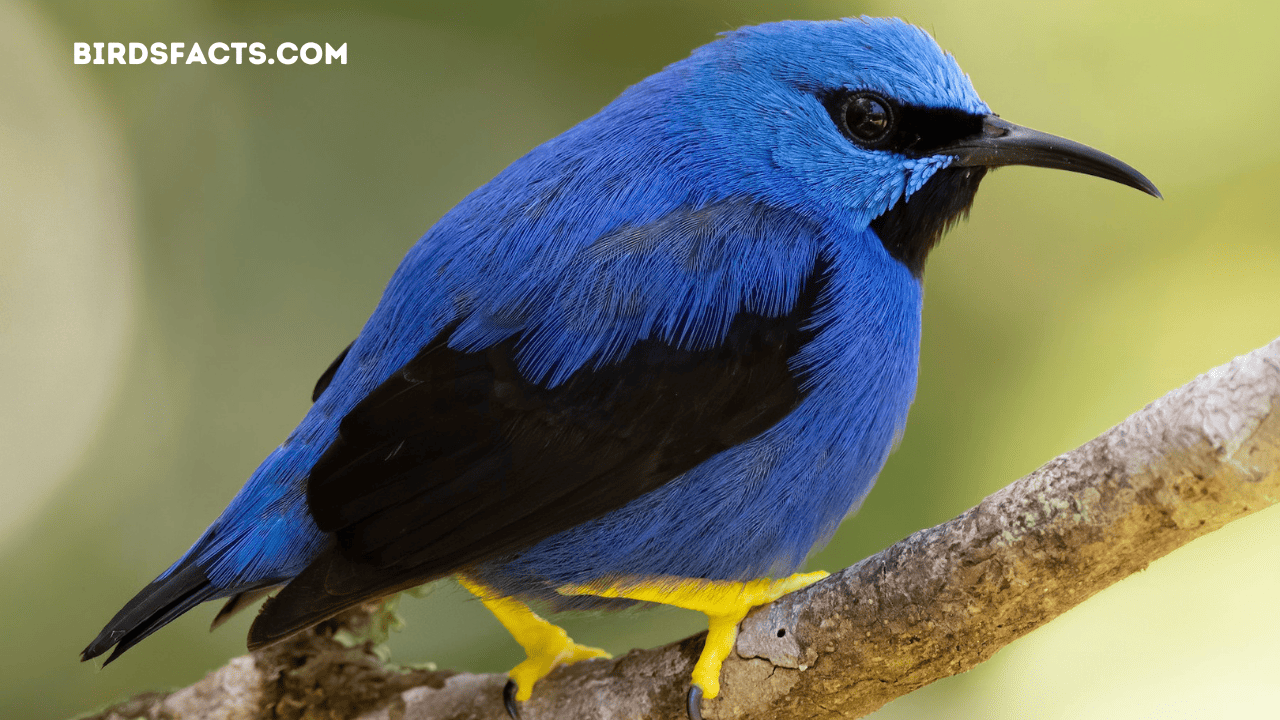
blue head bird
These birds are known for their melodious sounds and vocal behavior, often producing high-pitched calls and trills. Breeding occurs throughout the year, and males often engage in courtship displays to attract females. Overall, the Shining Honeycreeper is a striking bird species with a unique lifestyle and ecological significance. It plays an important role in pollination and seed dispersal within its habitat.
| Feature | Description |
|---|---|
| Common Name | The Shining Honeycreeper |
| Scientific Name | Cyanerpes lucidus |
| Habitat | Tropical forests with fruit-bearing trees |
| Diet | Nectar, fruits, and insects |
| Main Food Source | Various fruits and insects |
| Predators | Snakes, birds of prey, and mammals |
| Population Estimate | Approximately 500,000 individuals |
| Wingspan | Approximately 7 inches |
| Incubation Period | Around 13-15 days |
| Nesting Material | Moss, leaves, and bark |
| Geographic Range | Costa Rica, Panama, and Colombia |
| Plumage | Bright blue, green, and black feathers |
| Age of Molting | Not widely known |
| Melodious Sounds and Vocal Behavior | High-pitched calls and trills |
| Breeding Behavior | Breeding occurs throughout the year, with males engaging in courtship displays to attract females |
| Ecological Role | Pollination and seed dispersal within its habitat |
| Threats | Habitat loss due to deforestation |
| Systematic History | Relatively well-documented |
| Subspecies | Multiple subspecies with slight variations in distribution |
| Migration | Mostly passive, with no significant long-distance movements observed |
Bee Hummingbird
The Bee Hummingbird, scientifically known as Mellisuga Helena, is a fascinating little bird that belongs to the Trochilidae family and is native to Cuba. It is the smallest bird species in the world, measuring only 5-6 cm in length and weighing about 2.6 grams. Their most distinctive feature is their colorful plumage, with males having vibrant iridescent feathers that shine in hues of green and pink. This tiny bird has a wingspan of about 6.1 cm.
The Bee Hummingbird primarily feeds on nectar from flowers and occasionally consumes small insects and spiders. They are known to be solitary creatures and are often found in tropical and subtropical forests, gardens, and coastal areas of Cuba. Despite their small size, the Bee Hummingbird faces threats from predators such as snakes, lizards, and larger birds.
The estimated population size of this species is currently unknown, but habitat loss due to deforestation and human development is considered the biggest threat to their survival. In terms of nesting, the Bee Hummingbird builds its compact nest in small trees or shrubs, typically positioning it only a few meters above the ground. The incubation period for their eggs is around 15-17 days. Molting occurs throughout the year, with individuals molting their feathers at different times. The Bee Hummingbird is known for its vibrant colors, including iridescent greens and pinks on its plumage, and it has smooth skin. Their diet mainly consists of nectar from various flowering plants, their favorite food.
Field identification of the Bee Hummingbird can be made through their small size, distinctive colorful plumage, and rapid wing movements. This species’ scientific history and systematics have been studied extensively, with some subspecies being recognized within the Bee Hummingbird population.
They are found exclusively on the island of Cuba and do not migrate. Their vocal behavior includes high-pitched chirping sounds and trills during courtship and territorial displays. Breeding occurs throughout the year, but peak breeding occurs during the rainy season when food sources are abundant.

black bird with blue tint
In conclusion, the Bee Hummingbird is a remarkable bird species known for its small size, vibrant colors, and remarkable abilities. Despite its tiny stature, it faces habitat loss and predation challenges, emphasizing the importance of conservation efforts to protect this unique species.
| Attribute | Description |
|---|---|
| Common Name | Bee Hummingbird |
| Scientific Name | Mellisuga Helena |
| Family | Trochilidae |
| Native to | Cuba |
| Size | 5-6 cm in length |
| Weight | Approximately 2.6 grams |
| Wingspan | About 6.1 cm |
| Diet | Primarily feeds on nectar from flowers; occasionally consumes small insects and spiders |
| Habitat | Tropical and subtropical forests, gardens, and coastal areas of Cuba |
| Predators | Snakes, lizards, and larger birds |
| Population Size | Currently unknown; facing threats due to habitat loss |
| Nesting | Builds compact nests in small trees or shrubs, typically a few meters above the ground |
| Incubation Period | Around 15-17 days |
| Molting | Occurs throughout the year at different times |
| Colorful Plumage | Males have vibrant iridescent feathers in shades of green and pink |
| Vocal Behavior | High-pitched chirping sounds and trills during courtship and territorial displays |
| Breeding | Occurs throughout the year, with peak breeding during the rainy season |
| Endemism | Found exclusively on the island of Cuba and does not migrate |
| Conservation Status | Faces threats due to habitat loss; conservation efforts are important for protection |
Cerulean Warbler
The Cerulean Warbler, scientifically known as Setophaga cerulea, is a small and stunning bird species found in North America’s forests. With a vibrant cerulean blue coloration, this warbler stands out among its fellow avian inhabitants. Although the Cerulean Warbler is a small bird, measuring only about 4.5 inches in length and weighing around 0.3 ounces, it has a relatively large wingspan of about 7.5 inches. Its most distinctive feature is its striking blue plumage and white underparts, making it easily recognizable in the wild.
This warbler primarily feeds on insects and spiders, making them important predators in their habitat. They forage by hopping from branch to branch, gleaning their prey from the leaves and bark. The Cerulean Warbler can be typically found in mature deciduous and mixed forests, where they build their nests on horizontal branches. These nests are typically made of bark strips, twigs, grasses, and plant fibers, bound together with spider silk and lined with feathers and hair.
Unfortunately, the Cerulean Warbler population has been steadily declining in recent years due to habitat loss and fragmentation. Their breeding habitat is threatened by deforestation and the conversion of forests into agricultural land. Additionally, the widespread use of pesticides also poses a significant threat to the survival of this species.
Currently, there are believed to be only around 600,000 to 800,000 breeding adults of the Cerulean Warbler remaining. These birds migrate annually from their breeding grounds in North America to spend their winters in South America. During this migration, they mainly rely on forested habitats, including native and human-made woodlands.
Regarding sounds and vocal behavior, male Cerulean Warblers have a sweet and buzzy song, often described as “zee-zee-zoo-zee.” They use this song to establish their territory and attract mates. The incubation period for their eggs is approximately 12 days, and young singers fledge after about 10 to 12 days.

blue black bird
Overall, the Cerulean Warbler is an enchanting bird species that captivates birdwatchers with its brilliant blue color and captivating song. Efforts are being made to protect and conserve their habitat to ensure their survival for future generations.
| Bird Species | Cerulean Warbler |
|---|---|
| Scientific Name | Setophaga cerulea |
| Size | Approximately 4.5 inches in length |
| Weight | Around 0.3 ounces |
| Wingspan | Approximately 7.5 inches |
| Coloration | Vibrant cerulean blue with white underparts |
| Feeding Behavior | Primarily feeds on insects and spiders |
| Foraging Method | Hopping from branch to branch, gleaning prey |
| Habitat | Mature deciduous and mixed forests |
| Nest Building | Nests built on horizontal branches |
| Nest Composition | Bark strips, twigs, grasses, plant fibers, spider silk, feathers, and hair |
| Threats | Habitat loss, deforestation, conversion to agricultural land, pesticide use |
| Current Population | Estimated 600,000 to 800,000 breeding adults |
| Migration | Annual migration from North America to South America |
| Song | Male has a sweet and buzzy song – “zee-zee-zoo-zee” |
| Incubation Period | Approximately 12 days |
| Fledging Period | About 10 to 12 days |
Common Grackle
The Common Grackle, scientifically known as Quiscalus quiscula, is a bird species that can be found across North America. These birds have many habitats, from urban areas to wetlands and forests. Common Grackles have a varied diet, which includes insects, small vertebrates, seeds, and fruits.
They are omnivorous and opportunistic feeders, often seen foraging on the ground or raiding bird feeders. They have a distinctive appearance with a length of around 12-13 inches and a wingspan of approximately 17-18 inches. Their most distinctive feature is their iridescent black feathers and yellow eyes. Despite their name, the Common Grackle is a type of blackbird and is one of the 11 species in the Quiscalus genus.
The estimated population size of this bird species is quite large, with an estimated number of individuals ranging from a couple of million to over 50 million birds. The biggest threat to their population is habitat loss due to urbanization and deforestation. Common Grackles are known for their vocal behavior, with males often sounding a loud and distinctive call to attract females during the breeding season.
During incubation, which lasts about two weeks, the females build cup-shaped nests made of twigs and grasses in trees or shrubs. The young birds will molt their feathers at around one year of age and reach their adult plumage by their second or third year. Common Grackles are primarily black, but their heads have a bluish or purplish sheen. They have a sleek, shiny skin type and can weigh around 2.5 to 5 ounces.
These birds are highly adaptable and are known for their bold and scavenging behavior. Their favorite food includes corn, sunflower seeds, insects, and even small fish. Common Grackles can be identified by their long tail, thick bill, and large size compared to other blackbirds. In terms of subspecies, seven recognized subspecies of Common Grackle have different distributions across North America.

black blue jay
These birds undertake seasonal migrations, with their breeding range extending from Canada to the southern United States and their winter range reaching as far south as Mexico and Central America. Overall, the Common Grackle is a fascinating and adaptable bird species with a large population and wide distribution range.
| Property | Description |
|---|---|
| Common Name | Common Grackle |
| Scientific Name | Quiscalus quiscula |
| Habitat | Urban areas, wetlands, and forests |
| Diet | Insects, small vertebrates, seeds, and fruits |
| Feeding Behavior | Omnivorous and opportunistic; foraging on the ground and raiding bird feeders |
| Appearance | Length: 12-13 inches, Wingspan: 17-18 inches, Iridescent black feathers, Yellow eyes |
| Taxonomy | Type of blackbird, one of 11 species in the Quiscalus genus |
| Population Size | Estimated from a couple of million to over 50 million individuals |
| Threats | Habitat loss due to urbanization and deforestation |
| Vocal Behavior | Males produce loud and distinctive calls to attract females during the breeding season |
| Nesting Behavior | Females build cup-shaped nests of twigs and grasses in trees or shrubs during incubation (about 2 weeks) |
| Plumage Development | Molting of feathers around one year of age; reach adult plumage by second or third year |
| Physical Features | Primarily black with bluish or purplish sheen on heads, sleek and shiny skin, 2.5 to 5 ounces in weight |
| Adaptability | Highly adaptable and known for bold and scavenging behavior |
| Favorite Foods | Corn, sunflower seeds, insects, and small fish |
| Identification | Long tail, thick bill, and larger size compared to other blackbirds |
| Subspecies | Seven recognized subspecies with different distributions across North America |
| Migration | Seasonal migrations; breeding range from Canada to southern United States, winter range to Mexico and Central America |
| Summary | Fascinating and adaptable bird species with a large population and wide distribution range |
Purple Martin
The Purple Martin, scientifically known as Progne subis, is a bird species widely recognized for its vibrant purple feathers and melodic songs. They primarily feed on insects, making them highly beneficial to farmers and gardeners as they help to control pest populations. An interesting fact about Purple Martins is that they rely heavily on human-made birdhouses for nesting, often forming large colonies in these structures. With an estimated population size of around 6-7 million individuals, they are currently listed as a species of least concern.
However, due to urban development, their biggest threat is the loss of suitable nesting habitat. One of the most distinctive features of the Purple Martin is its long wingspan, which can reach up to 16 inches. The incubation period for their eggs is typically around 15-18 days. Purple Martins are found throughout North and South America, with their habitat ranging from open woodlands to urban areas.
Their natural predators include snakes, raccoons, and other bird species. Their diet consists mainly of flying insects such as dragonflies and mosquitoes. Purple Martins are birds of the swallow family commonly known as “martins.” There are three species of martins, with the Purple Martin being the largest. They are easily identified by their dark purple feathers and their sleek body shape. Regarding systematics history, the Purple Martin has six recognized subspecies, each with slightly different distributions.
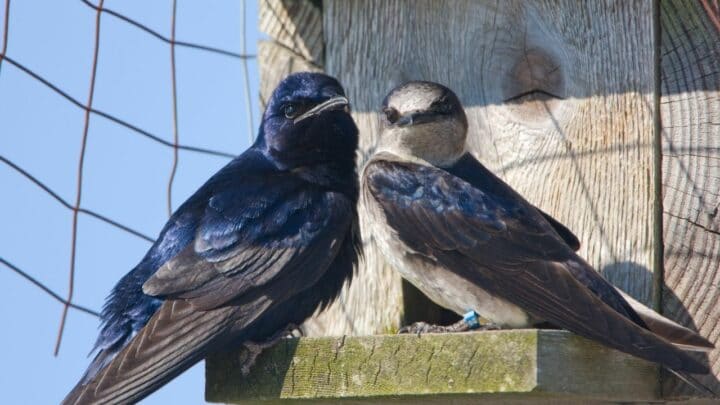
small dark blue bird
They are known for their annual migration, with the birds traveling from their summer breeding grounds in North America to their wintering grounds in South America. During the breeding season, male Purple Martins are known for their complex and melodic songs, which they use to attract female mates. The Purple Martin is a captivating bird species known for its beautiful plumage, social behavior, and important ecological role in controlling insect pests.
| Aspect | Information |
|---|---|
| Scientific Name | Progne subis |
| Common Name | Purple Martin |
| Description | A bird species widely recognized for its vibrant purple feathers and melodic songs. They primarily feed on insects, making them highly beneficial to farmers and gardeners as they help control pest populations. |
| Nesting Behavior | They heavily rely on human-made birdhouses for nesting and often form large colonies in these structures. |
| Population Size | Approximately 6-7 million individuals, currently listed as a species of least concern. |
| Wingspan | Up to 16 inches. |
| Incubation Period | Typically around 15-18 days. |
| Habitat | Found throughout North and South America, with habitats ranging from open woodlands to urban areas. |
| Predators | Snakes, raccoons, and other bird species. |
| Diet | Mainly consists of flying insects such as dragonflies and mosquitoes. |
| Family | Birds of the swallow family commonly known as “martins.” |
| Subspecies | Six recognized subspecies, each with slightly different distributions. |
| Migration | They migrate annually from their summer breeding grounds in North America to their wintering grounds in South America. |
| Breeding Season | Male Purple Martins are known for their complex and melodic songs used to attract female mates during the breeding season. |
| Ecological Role | Important ecological role in controlling insect pests. |
Indigo Bunting
The Indigo Bunting, scientifically known as Passerina cyanea, is a small songbird that belongs to the Cardinal family. It is commonly found in North America, especially in the eastern and central regions. The Indigo Bunting is known for its vibrant blue feathers, its most distinctive feature. It has a wingspan of about 7 to 9 inches and weighs around 0.6 to 1.0 ounces. The bird is primarily insectivorous, feeding various insects, especially beetles and grasshoppers. Its diet also includes seeds and berries. The Indigo Bunting is a migratory bird with an estimated population size of around 20 million individuals. Its biggest threat is habitat loss due to deforestation and human development.
The Indigo Bunting’s habitat includes open woodlands, fields, and meadows, where it can find the necessary food sources. It builds its nests in shrubs or low trees, usually about 3 to 10 feet above the ground. The incubation period for its eggs is around 12 days. The bird starts molting its feathers at around one year of age. During this time, its bright blue feathers are replaced by duller brown feathers, making it difficult to identify. Once the molting is complete, the vibrant blue color returns. The Indigo Bunting is known for its melodious song, which consists of a series of high-pitched, warbling notes.
Regarding its taxonomy, the Indigo Bunting belongs to the Passerina genus, which includes several other species of buntings. There are no recognized subspecies of the Indigo Bunting. The bird is found across its breeding range in North America, from southern Canada to northern Florida and west to the Rocky Mountains. It can also be seen in parts of Central America and the Caribbean during migration.
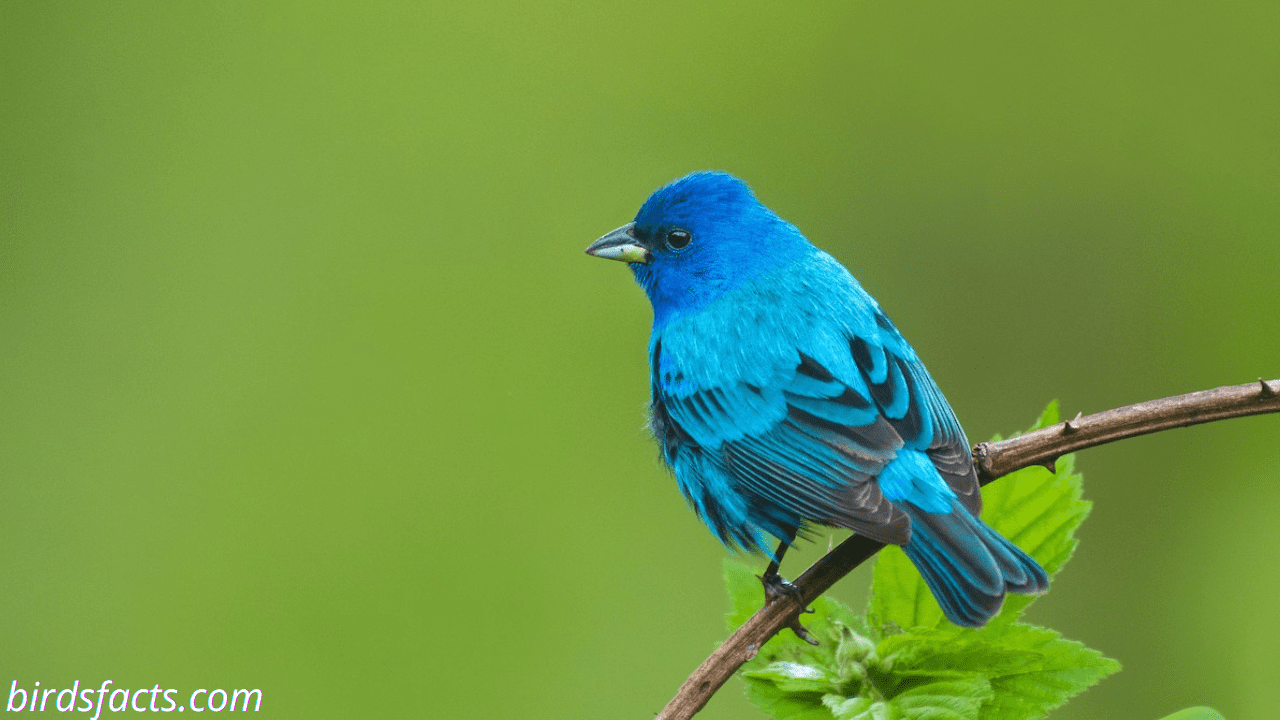
black white and blue bird
Overall, the Indigo Bunting is a beautiful and ecologically important bird with its vibrant blue feathers and melodious song. However, its population is under threat due to habitat loss. Efforts are needed to protect its habitats and ensure its survival for future generations.
| Attribute | Information |
|---|---|
| Scientific Name | Passerina cyanea |
| Common Name | Indigo Bunting |
| Family | Cardinal |
| Geographic Range | North America (especially eastern and central regions) |
| Feathers | Vibrant blue |
| Wingspan | Approximately 7 to 9 inches |
| Weight | Around 0.6 to 1.0 ounces |
| Diet | Primarily insectivorous (feeds on insects, especially beetles and grasshoppers), seeds, and berries |
| Population Size | Approximately 20 million individuals |
| Threats | Habitat loss due to deforestation and human development |
| Habitat | Open woodlands, fields, and meadows; builds nests in shrubs or low trees, 3 to 10 feet above the ground |
| Incubation Period | Around 12 days |
| Molting | Starts at approximately one year of age; bright blue feathers replaced by duller brown feathers during molt |
| Song | Melodious, consisting of a series of high-pitched, warbling notes |
| Taxonomy | Belongs to the Passerina genus; no recognized subspecies |
| Breeding Range | North America (from southern Canada to northern Florida and west to the Rocky Mountains) |
| Migration | Seen in parts of Central America and the Caribbean during migration |
Steller’s Jay
Steller’s Jay, scientifically known as Cyanocitta stelleri, is a visually striking bird in western North America. Steller’s Jay is easily identifiable with its vibrant blue coloration and prominent crest. This species has a wingspan of around 16 inches and can weigh up to 3.5 ounces. It has a length of about 11.5 inches, making it a medium-sized bird. Steller’s Jays are known for their distinctive feature of having dark blue feathers on their head and body, with lighter blue feathers on their wings and tail. Their sleek, feathered skin type allows for swift flight and maneuverability in their forested habitat.
Steller’s Jays mainly inhabit coniferous and mixed woodlands, often in mountainous regions. They can also be seen in parks and suburban areas with suitable forested habitats. These birds have a diverse diet, feeding insects, berries, seeds, and small vertebrates. Their diet consists of both animal and plant matter, making them omnivorous.
Regarding reproduction, Steller’s Jays build their nests in conifer trees, usually in coniferous foliage. The incubation period for their eggs lasts around 16 to 18 days, and the young birds remain in the nest for another 17 to 21 days before fledging. Steller’s Jays begin molting at around one year of age, lasting about six weeks.
One interesting fact about Steller’s Jays is their ability to mimic sounds, including the calls of other birds and even human voices. This vocal behavior is often used for communication and territorial defense. Their sounds range from loud and harsh calls to softer, melodic trills.
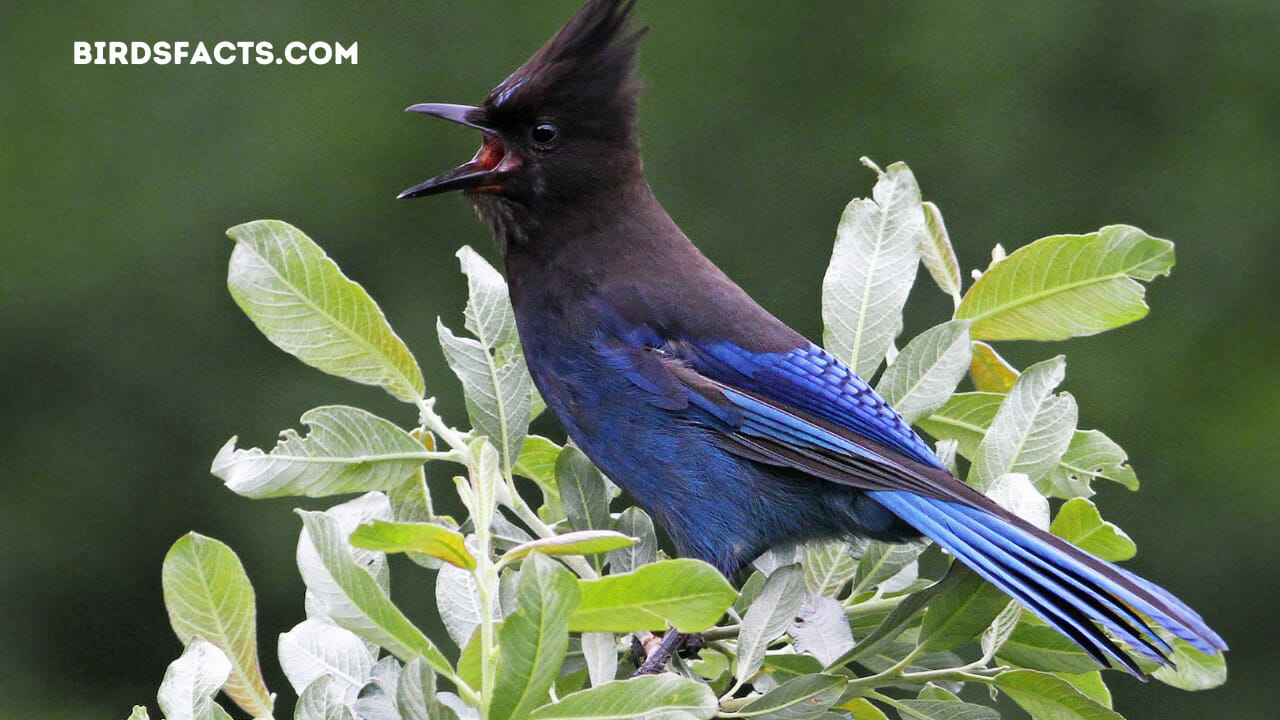
black and white bird with blue tail
However, despite their adaptability and relatively large population, Steller’s Jays face threats. Their biggest threat comes from habitat loss due to deforestation and urbanization. This is particularly concerning as Steller’s Jays play a crucial role in seed dispersal and maintaining the balance of their ecosystems. With an estimated population size of over 5 million individuals, conservation efforts are necessary to protect this species and its habitat.
| Property | Information |
|---|---|
| Common Name | Steller’s Jay |
| Scientific Name | Cyanocitta stelleri |
| Visual Description | Vibrant blue coloration with prominent crest |
| Wingspan | Approximately 16 inches |
| Weight | Up to 3.5 ounces |
| Length | About 11.5 inches |
| Feathers | Dark blue on head and body, lighter blue on wings and tail |
| Habitat | Coniferous and mixed woodlands, mountainous regions, parks, and suburban areas with suitable forested habitats |
| Diet | Insects, berries, seeds, and small vertebrates |
| Diet Type | Omnivorous |
| Nesting | Built in conifer trees, typically in coniferous foliage |
| Incubation Period | Around 16 to 18 days |
| Nestling Period | About 17 to 21 days |
| Molting Age | Starts at around one year of age, lasting about six weeks |
| Vocalization | Ability to mimic sounds, including calls of other birds and human voices |
| Threats | Habitat loss due to deforestation and urbanization |
| Population Size | Over 5 million individuals |
| Conservation Efforts | Necessary to protect species and its habitat |
Black-billed Magpie
The Black-billed Magpie, scientifically known as Pica hudsonia, is a fascinating bird with its distinct black-and-white appearance and long tail. This species can be found in various habitats across North America, including open woodlands, grasslands, parks, and gardens. Black-billed Magpies have a wingspan of around 53-61 centimeters and can weigh up to 200 grams. They are known for their social behavior and can often be seen in large groups.
As omnivores, Black-billed Magpies have a diverse diet, feeding on various foods such as insects, small mammals, fruits, seeds, and even garbage. Their favorite food, however, is carrion, making them scavengers by nature. Their field identification is distinct, with their black feathers contrasting sharply against the white markings on their wings, belly, and tail.
Black-billed Magpies are known for their vocal behavior and can produce various sounds, including harsh calls and melodious whistles. During the breeding season, they build large nests made of twigs and grasses in trees or shrubs, usually located near water sources. The incubation period typically lasts around three weeks, and the birds will defend their nest aggressively against predators, including other birds and mammals.
While the Black-billed Magpie population is estimated to be stable, their biggest threat is human activity, particularly habitat destruction and pesticide use. Additionally, they may face predation from larger birds, such as raptors and owls. These birds are known for their intelligence and can use tools to obtain food. They are also famous for their thieving behavior, often stealing shiny objects and storing them in their nests.

black birds with blue necks
Overall, the Black-billed Magpie is a highly adaptable and intelligent bird. Its striking appearance, social behavior, and unique feeding habits make it a fascinating species to observe in the wild. As long as conservation efforts are in place to protect their habitat, the Black-billed Magpie population should continue to thrive.
| Property | Information |
|---|---|
| Common Name | Black-billed Magpie |
| Scientific Name | Pica hudsonia |
| Appearance | Distinct black-and-white with long tail |
| Habitat | Various habitats across North America (open woodlands, grasslands, parks, gardens) |
| Wingspan | Around 53-61 centimeters |
| Weight | Up to 200 grams |
| Diet | Omnivorous – insects, small mammals, fruits, seeds, garbage, carrion (favorite food) |
| Social Behavior | Seen in large groups, known for vocal behavior with harsh calls and melodious whistles |
| Nesting | Build large nests of twigs and grasses in trees or shrubs, located near water sources during breeding season |
| Incubation Period | Typically lasts around three weeks |
| Nest Defense | Aggressively defend nests against predators, including other birds and mammals |
| Threats | Human activity (habitat destruction, pesticide use), predation from larger birds (raptors, owls) |
| Intelligence and Behavior | Known for intelligence, tool usage for obtaining food, thieving behavior (stealing shiny objects) |
| Conservation Status | Population estimated to be stable, conservation efforts needed to protect habitat |
Brown-Headed Cowbird
The Brown-Headed Cowbird, scientifically known as Molothrus ater, is native to North America. It is a brood parasite, meaning it lays its eggs in the nests of other bird species, leaving the responsibility of raising its young to the host parents. The Brown-Headed Cowbird preys on the eggs and nestlings of over 220 bird species.
A fun fact about the Brown-Headed Cowbird is that it does not build its nests. Instead, it relies on other bird species to do so. The estimated population size of this bird is currently unknown, as it is difficult to track accurately due to its parasitic breeding behavior.
The biggest threat to the Brown-Headed Cowbird is habitat loss and fragmentation. As humans continue encroaching on their natural habitats, these birds face a decrease in suitable nesting locations.
One of the most distinctive features of the Brown-Headed Cowbird is its brown head, which contrasts with the rest of its black body. The wingspan of this bird typically ranges from 13 to 17 inches.
The incubation period for Brown-Headed Cowbird eggs is around 10 to 11 days. These birds can be found in various habitats, including open woodlands, grasslands, and agricultural fields.
Predators of the Brown-Headed Cowbird include birds of prey, such as hawks and owls, and mammals, like raccoons and skunks.
The diet of the Brown-Headed Cowbird mainly consists of seeds, insects, and fruits. They forage on the ground or in low vegetation, using their strong bills to open seeds and capture insects.
The Brown-Headed Cowbird is a passerine bird, meaning it belongs to Passeriformes. There is only one species of Brown-Headed Cowbird, and it is found throughout North America, from southern Canada to northern Mexico.
When it comes to nesting, the Brown-Headed Cowbird chooses a variety of locations, depending on the host species. This can include shrubs, trees, or even on the ground.
The age at which the Brown-Headed Cowbird molts varies but typically occurs within the first year of its life.
In terms of appearance, the Brown-Headed Cowbird is mostly black, with a brown head and a dull grey bill. It has a thin, pointed beak and a bare skin patch around its eyes.
The average weight of a Brown-Headed Cowbird is around 30-60 grams, and its length ranges from 7.5 to 8.75 inches.

black bird blue chest
The lifestyle of the Brown-Headed Cowbird is unique as it relies on others to raise their young. They are opportunistic and can be found in various habitats, searching for suitable nests to lay their eggs.
| Feature | Description |
|---|---|
| Scientific Name | Molothrus ater |
| Native Range | North America |
| Breeding Behavior | Brood parasite – lays eggs in other bird species’ nests |
| Predatory Behavior | Preys on the eggs and nestlings of over 220 bird species |
| Nesting Behavior | Relies on other bird species to build nests |
| Population Size | Currently unknown due to difficulty in tracking accurately |
| Threats | Habitat loss and fragmentation caused by human encroachment |
| Distinctive Feature | Brown head contrasting with the black body |
| Wingspan | 13 to 17 inches |
| Incubation Period | Around 10 to 11 days |
| Habitats | Open woodlands, grasslands, and agricultural fields |
| Predators | Birds of prey (hawks and owls) and mammals (raccoons and skunks) |
| Diet | Mainly seeds, insects, and fruits; forages on the ground or in low vegetation |
| Bird Classification | Passerine bird (belongs to Passeriformes) |
| Geographic Range | Throughout North America, from southern Canada to northern Mexico |
| Nesting Locations | Varied depending on the host species; can be shrubs, trees, or on the ground |
| Molting | Typically occurs within the first year of its life |
| Appearance | Mostly black with a brown head, dull grey bill, thin pointed beak, and a bare skin patch around the eyes |
| Average Weight | Around 30-60 grams |
| Length | 7.5 to 8.75 inches |
| Lifestyle | Opportunistic, relying on others to raise their young; found in various habitats |
FAQ
What kind of bird has blue and black?
The blue and black color combination is common among several bird species. One example is the male Eastern Bluebird, which showcases vibrant blue feathers on its back and wings, contrasting with black markings on its head and tail. This striking coloration helps attract mates and establish territorial boundaries. AdditOthers, such as the Violet-backed Starling and the Blue Jay, also exhibit a similar blue and black plumage pattern.
What is a black bird with bright blue wings and a tail?
A black bird with bright blue wings and tail is a stunning creature that captivates onlookers with its unique coloration. With its striking contrast between the deep black feathers and the vibrant blue highlights, this bird stands out among its peers in the avian world. Its appearance is breathtaking, leaving observers in awe of its beauty and grace.
What is the name of the blue, black, and white bird?
The bird with blue, black, and white colors is commonly known as the Blue Jay. The Blue Jay is a medium-sized songbird easily identified by its vibrant blue feathers on its wings and tail, black crest, back, and white underparts. It is known for its noisy and assertive nature, as well as its striking appearance.
What is a big black bird with a blue chest?
A big black bird with a blue chest is most likely the Eurasian Jackdaw. They are known for their shiny black feathers and distinctive blue coloration on their breast. These intelligent and social birds can be found in various parts of Europe, Asia, and North Africa. The blue chest makes them easily recognizable and adds a touch of vibrancy to their otherwise dark plumage.
What bird is black with blue?
The bird that is black with blue is the blue Jay. This striking bird is mostly black, with patches of vibrant blue on its wings and tail. It is known for its beautiful and distinctive appearance, making it easily recognizable in the wild.
Further Reading
You may also check out:
- Blue Birds In Pennsylvania
- Blue Colored Birds
- Blue Birds in Michigan
- Birds With Orange Beaks
- Gsm A2z Tool
Thank you for reading!




